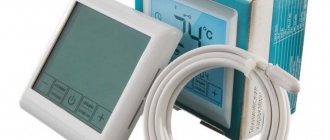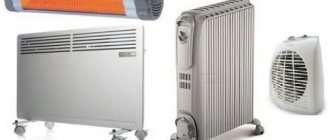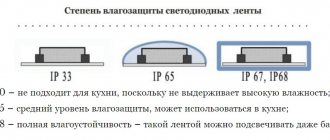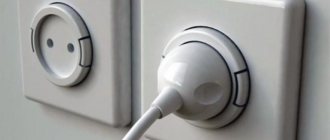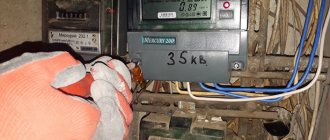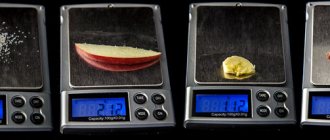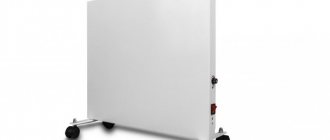Good day to all! What is so necessary in winter when the batteries are either turned off, or when they provide little heat - that’s right, heaters. Heaters help us maintain a comfortable room temperature in winter. Sometimes heating batteries is simply not enough, or heaters are used where there is no heating system, these are garages, cottages, pavilions, kiosks, etc. Before using a heater, you should first calculate how much electricity heating devices consume, and how much you will have to pay for electricity. Today we'll try to figure it out.
So, the most popular heaters are the following types:
Fan heater
A fan heater is a small gun, inside there is a coil that heats up and a fan that quickly disperses the heat; this is the cheapest and most accessible option for heating a room. The air combustion of this device is the strongest, unlike others, so its use requires periodicity, that is, switching on with short breaks. Another disadvantage of this type is the noise of the fan; there is no noise in other heaters.
Heat guns
In fact, these are large fan heaters, since the principles of their operation are the same. Accordingly, the shortcomings are the same. Guns create a lot of noise, although their incomparable advantage is the fastest heating of large rooms. They are used to warm up warehouses, as well as when installing suspended ceilings to warm up the fabric, which stretches naturally after cooling.
An overview of models and prices is in the table.
| model | specifications | price, rub |
| MASTER V 3.3 | 6200 | |
| Ballu BHP-PE-5 | 3200 | |
| RESANTA TEP-2000 | 1900 | |
| RESANTA TEP-9000 | 4500 |
Convection heater
Convection heater - considered one of the safest heaters, the principle of operation of a convection heater is mixing and circulation of air layers, at the bottom of the convector there is a grill through which air enters, and already heated air exits through the holes at the top. The convector has protection against tipping over and overheating; this type of heater can be hung on the wall for convenience; it has a flat shape and small size.
Which heater consumes less electricity for a summer house and other homes?
Based on many experiments, we can single out one type that consumes less electricity. Such a device is a convector. The operating principle is similar to an oil radiator, but is distinguished by its safety and modernity.
Air circulates through the heating element, which is located in the convector. Thus, heat exchange occurs. The convector can be left on for a long time unattended, as it is one of the safest devices.
Such heating equipment is ideal for a country house. It does not dry the air, and the heating temperature cannot exceed 60 °C. After turning on the convector, the room will begin to heat up after 20 minutes. It consumes 25% less electricity than other heating devices.
The convector is considered the most economical for the home.
Infrared heater
Infrared heater - the operating principle of such a heater is based on infrared radiation, which heats various objects in the room, and the objects heat the air, this is the most natural way of heating the air. The oxygen combustion rate, in contrast to other heater models, is much lower.
Each type of heater has its own recommended room volume to fully warm it up.
Correct calculation of heating water with electricity (video)
In this article we examined the most popular calculations that are carried out using a heating tank. Thanks to simple steps and the help of special online calculators, you can find out your indicators and determine whether you should do something to save money or not. All other actions were outlined in detail in our article above.
During the cold season, residents of private houses think about a comfortable indoor temperature. But among the many heating equipment, it is difficult to choose the best option. Many people choose electrical products that have many benefits and consume a small amount of electricity. Let's consider which heater is the most economical for a private home in terms of electricity.
What affects the electricity consumption of a heater?
The main characteristic by which you can determine how long the heater will run is the power consumption of the device. The higher it is, the correspondingly greater the electricity consumption will be. It is also worth noting that consumption depends on the mode in which it operates.
Convection heaters generally have an energy consumption of 750 W, 1 kilowatt, 1500 Watt 2 kW, maybe more. For fan heaters, consumption is 1500-2000 W per hour. For oil-based ones, the same limits range from 1000 to 2000 W/hour.
Let's calculate how much electricity the heater will consume if it operates at full power of 2000 W. In total we get 2 kW per hour. If we assume that in winter the heater heats for an hour and rests for 2 hours, we get 8 hours of operation.
2*8 = 16 kW per day, and if we take the average price for 1 kW of electricity as 4 rubles, then we get 16*4 = 64 rubles. in a day. The numbers may be lower if you initially use it at full power for a couple of hours and then use a lower consumption mode to maintain the temperature.
Based on the data obtained during the calculations, you can calculate how much electricity the heater will consume in 1 month and for the entire cold period.
Thus, in order to determine how much electricity a heater consumes, it is enough to know its power consumption in the absence of operating modes, and if there are heating modes, to know how much electricity each consumes.
Oil heating radiators will be indispensable assistants during the period when the air temperature in the room becomes too low and uncomfortable for living. They serve as additional sources of heat in the off-season, when the central heating system is not yet operating. The devices are used on cool days in the country house, country house, garage, construction trailer, etc.
Review of manufacturers
The modern Russian market offers a large selection of economical electric heaters of both domestic and foreign (mainly European) production.
- Almac (Almak) is a Russian brand under which domestically produced heat regulators, heat guns, fans and heaters are sold. The models have affordable prices and are well suited for infrequent use - this way they will last as long as possible.
- BALLU is an international company specializing in heating equipment for home and professional use. Mainly produces infrared heaters (wall and ceiling). They can be used in a city apartment as additional heating sources.
- TIMBERK is a Swedish brand whose products are distinguished by their special quality. Assembly is carried out in Russia, Poland and other countries, but at each stage there are quite a lot of quality requirements for the process, so you can count on the durability of the device.
- FRIRO is a Swiss manufacturer, its heating equipment is distinguished by its special quality and durability, which is why it still remains a leader in the European product market.
- ECOLINE is a brand of the Russian company TST. The products largely comply with European quality standards, but they are also more expensive in price than other Russian products.
Thus, first of all, one should proceed from the frequency of use of the heater. If you plan to use it every day or more than 4 times a week, preference should be given to European models, which are durable. For normal urban use (i.e. only during periods of maximum cold), domestic models are suitable.
Design and principle of operation of the heater
The operating principle and design of the oil heater are the same for all types of such devices. It is a sealed metal structure consisting of several sections. The working fluid is mineral oil, which is heated by a tubular electric heater located inside the device. The heated oil transfers thermal energy to the housing, which already heats the air in the room.
Understanding how a household oil heater works and works, it is much easier to decide on the choice of model.
Classification of oil radiators
Oil electric heating devices are classified as follows:
- Floor radiators. The most popular and widespread type of oil heaters. The device is equipped with special wheels for ease of movement. Often such devices are universal in terms of installation type, i.e. they allow the use of both floor mounting and wall mounting.
- Wall radiators. Using the brackets that come with these heaters, they are hung on the wall. Compared to floor-mounted structures, wall-mounted modifications are less powerful and have lower heat transfer.
- Baseboard heaters. The latest modified development of the device with wall mounting. The device is placed at the bottom of the wall, which ensures good air circulation. It is used as a full-fledged heat source, which is an alternative to central heating.
- Heaters with thermostat. In order to ensure uninterrupted operation of the device for a long time and reduce energy consumption, electronic thermostats are built into the heaters, maintaining the set temperature and eliminating possible changes.
- Heaters with fan. To speed up air heating, the devices are equipped with built-in fans, which additionally redistribute the flow of air masses. A negative point inherent in these varieties is the noise when the fan operates.
Advantages and disadvantages
Oil-fired electric heating radiators have a number of positive qualities, including:
- Compactness. These batteries take up little space.
- Mobility. Thanks to wheels, most models can be easily moved from room to room.
- Safety. The metal body does not heat up above +60…+70°C, which eliminates the possibility of burns and injuries. All working elements heated to high temperatures are located inside the casing.
- Silence. Oil batteries do not make noise during operation (except for models equipped with fans).
- They do not dry out the air in the room, do not burn out oxygen and do not emit unpleasant odors (compared to devices with open heating elements).
- Reasonable price.
- Easy to use. You just need to plug the cord into a power outlet and follow simple rules.
The disadvantages of such structures include the following qualities:
- Inertia. Mineral oil takes a long time to reach operating temperature (due to its large heat capacity) and the room heats up slowly. But the liquid does not cool down immediately, gradually releasing the accumulated heat.
- Quite a lot of weight and dimensions, which is not always convenient. The disadvantage is compensated by the presence of wheels.
Convectors
These are modern and quite effective devices that can warm up a large room in a short time. The basis of the heating element is a spiral made of a special metal alloy. The air in the room passes through the convector and comes out of the grille already warm.
Such a device is located on the floor, due to which the cold air is immediately warmed up and neutralized by warm air - a natural movement of the air mass occurs - convection, which is why the name of the heater comes from. The advantage of a convector is the rapid heating of large volumes of the room and completely silent operation. Plus, it doesn't take up much space. There are practically no disadvantages.
Models and prices for them are presented in the table.
| model | specifications | price, rub |
| Ballu BEP/EXT-1500 | 4600 | |
| Electrolux ECH/AG-1000MFR4 | 2700 | |
| RESANTA OK-500S | 900 | |
| Ballu BEC/EVM-1500 | 2200 | |
| Ballu BEC/EM-1000 | 1700 |
How to choose an oil heater, which one is better
To understand which oil heater is better, you need to consider a number of important characteristics:
- Power. The most important parameter to choose from is the power of the heating device. It is believed that it is optimal to take heaters at the rate of 1 kW per 10 m² of area. It is recommended to purchase a radiator with a power reserve so that it does not constantly work at maximum and does not exhaust its resource too quickly. For rooms with a large area, it is better to take several low-power devices and place them in different places in the room than to use 1 powerful device. This way the heating will be more uniform.
- Width and thickness of sections. These indicators should have average values. Excessively thick sections take a long time to heat up, which directly affects energy costs. Narrow sections heat up faster, but have a small area and less heat transfer.
- Weight. Structurally, oil heaters cannot be lightweight. If a large-sized device has a suspiciously small mass, then you should not choose it. Such a device may be made of thin metal or the oil level in it may be lower than required.
- Power switch. The presence of different power modes, overheating protection functions and an adjustable thermostat significantly increases the efficiency of the device and reduces energy costs.
- Humidifier. Such heaters dry the air to a much lesser extent than similar heating devices. But with prolonged use, the humidity may decrease, so it is recommended to use devices equipped with a water container. This is especially important for residential premises (bedrooms, children's rooms, etc.).
- Built-in fan. To increase the heating speed, manufacturers equip heaters with fans that promote rapid movement of air flows. This way the heat spreads throughout the room more efficiently.
- Functionality and safety. The best oil heaters are equipped with overheat protection, a protective cover (for children's rooms), remote control and other useful features.
We calculate the energy for heating water
All symbols of the device are indicated in the documentation that comes with the equipment. But we will take the average value, which is the most common.
Necessary indicators for calculation:
- Number of kilowatts,
- The volume of water consumed per day.
We will look at the most popular 50 liter boiler.
First you need to determine the time it takes for it to heat a full tank of water to 70 degrees. The average heating time for water from cold to hot is 2 hours, which means that the water is heated within two hours twice a day.
Why a lot of electricity is wasted can be found out based on the volume of the storage tank. The documentation for the equipment states that the electricity consumption is 2 kilowatts per hour when the device is operating. And so we calculate if the heater takes 2 kW per hour, and per day it works 2 times for two hours, then we get 8 kW per day. Next, we determine the amount of electricity in heating mode. The resulting 8 kW must be divided by the number of hours that do not participate in the operation of the water heating device. It turns out that we divide 8 kW by 20 hours and get 0.4 kW per day spent on maintaining the required temperature. We calculate the total amount of energy required by a 50-liter boiler.
How much electricity does an oil heater consume?
The main criterion by which you can calculate how many kilowatts an oil heater consumes is the power consumption of the device. The higher this indicator, the greater the energy consumption of the device. But the equipment does not always work at full capacity. How much a heating device consumes directly depends on the mode in which it operates.
If you take an oil heater whose electricity consumption is 2 kW, then at full power it will consume 2000 W. The thermostat periodically turns off the heating elements, so the operating time will be no more than 8 hours a day. The consumption will be about 16 kW per day. When you multiply this number by the current tariff (price of 1 kW), you get the cost of consumed electricity for 24 hours of operation. Based on these calculations, monthly consumption is calculated.
It is possible to calculate the cost of heating for a month or for the entire heating period if you know the power characteristic of each heating mode. Most often, the energy consumption of an oil heater is much lower than the maximum values due to the operation of the thermostat, which turns off the device when the desired temperature is reached.
Consumption calculations
The energy consumption of heaters depends on 3 characteristics:
- Power.
- Heating mode.
- Working hours.
Let's calculate the heater in maximum mode with a power of 1000 Watt (meaning that it consumes 1000 W or 1 kW/hour).
Let's assume that the heater operates for 6 hours a day: 6(operating time) * 1(power in kW) = 6 kW/day.
Per month, the heater in a 6-hour operating mode consumes: 6 (consumption per day) * 30 (days per month) = 180 kW/month.
The amount of payment for the energy spent by the heater: 180 * 3.5 rubles (for example, the tariff for 1 kW/hour, there are different tariffs in each region, district, city and village) = 630 rubles/month.
If the furnace operates in other modes or for more (less) time, the consumption will be different.
Video about oil heater consumption.
Oil for oil heater
The question of what kind of oil is in the heater rarely has to be decided, since these devices are always hermetically sealed to prevent evaporation and leakage of the working substance. During operation, replacement is required extremely rarely.
If depressurization occurs, then adding oil will not be enough; first you need to repair the housing and solder the leak. After the seal has been restored and if there is a technological hole for filling the liquid, it is possible to refuel or change the oil.
You can fill an oil heater with various transformer, mineral automobile (transmission) and sometimes even waste oils. It is important to remember that you should not mix oils of different origins in the radiator, as an unpleasant reaction may occur (a sediment will form, the composition will thicken, etc.). Only substances of identical composition may be added. It is not recommended to do this on your own. It is better to carry out repair work in specialized service centers.
Why does the oil heater click?
Sometimes the oil cooler cracks during operation. If the device clicks when heating up, and the extraneous noise lasts no more than 3-5 minutes, then this can happen for the following reasons:
- Moisture (water vapor) has entered the sealed housing with oil. This can happen if the radiator was assembled in a damp room. When the appliance is turned off and the oil is cold, water condenses. When you turn on the device, the water heats up much faster than oil. A clicking sound is heard when boiling. When all the liquid turns into a gaseous state, the cracking stops.
- When the radiator is moved or accidentally dropped, the working fluid is shaken and mixed with air. When the device is turned on and the temperature rises, the air bubbles expand, increase in volume, and then rise up. When they burst, a clicking sound is heard. After the oil has completely warmed up, the sound disappears.
- Metal structural elements expand and crack when heated. Most often, the bimetallic switch in the thermal relay clicks. When heated, it opens, and when it cools to the required temperature, it closes again. This process is accompanied by a characteristic click.
Defects are extremely unpleasant, but there is no way to eliminate them. Such noises do not affect the functioning of the heater and therefore are not considered a defect.
If the alarming sounds do not go away after warming up, then the reason is more dangerous, since normal operation of oil radiators should be silent (excluding fan noise). This can be caused by electrical failures or defects in the casing. If the crackling noise lasts too long, the heater must be repaired. It is not recommended to try to repair the device yourself.
Is an oil heater dangerous? Safety precautions
To the question of whether an oil heater can explode, the answer is a clear negative, since oil is not an explosive liquid. If excessive heating occurs, for example in the event of a thermal relay failure, the housing may depressurize and leak hot oil. Heated liquid may ignite and cause a fire.
To ensure safety during operation of oil heaters, the following rules must be observed:
- Do not use the devices in rooms with high levels of humidity (bathroom).
- It is prohibited to dry laundry on the device without special equipment, or to place things on it or cover it with a cloth. Overheating may result in oil leakage.
- Do not place the heater closer than 0.5 m from the walls, as the thermal relay will constantly turn off the device.
- The device should only be held in an upright position. The oil in the housing is not filled to the very top, so when the device is laid on its side, the heating element is exposed. This is dangerous due to overheating of the liquid and depressurization.
- Do not pull the device by the cord to move it around the room, because a broken cord may cause a short circuit.
- It is necessary to ensure that the cable does not touch hot sections, since the braiding (insulation) may melt.
- You cannot keep an oil radiator in an unheated room in winter (on a balcony, loggia, etc.).
- If the overheat sensor is not working, the device cannot be turned on.
Oil heaters are safe devices to use if simple rules are followed. The risk of unpleasant consequences is minimized.
Manufacturers produce goods, and dealers say that oil heaters burn air or dry it out. In Europe, the temperature of radiators is maintained at 60 degrees Celsius. In Russia, this limit is too high, but in practice we see 37.
So it turns out that we are thinking about buying an oil heater that does not dry the air.
Operating principle of oil heater
The temperature of the oil heater is controlled by a bimetallic plate located in the electronics unit. Stuck to the side of the main accordion. The air passes from the bottom of the compartment, heats up on the sidewall, and comes out to the surface. Few people think about the temperature of a sectional radiator.
The manufacturer has many models of heaters. Selecting spare parts for each will cost a lot. As a result, the device will lose its main advantage - low price. What to do in this case. Models from the line are equipped identically. There are identical protective relays and bimetallic plates.
On the other hand, an oil heater has high inertia due to its massiveness. This means the air warms up slowly. The operation of the heating element is controlled by a bimetallic plate. The device heats up until the bimetallic plate operates. At the same time, the radiator temperature in oil heaters remains the same.
An oil heater consumes electrical energy, sending it to the heating element. The power of the heating element depends on the resistance of the coil. Both small and large devices consume the same amount. An instance with more oil takes longer to heat up and gives off more heat.
Heater for a small room
- The power lost by the surface of the heater is proportional to two quantities: the temperature difference between the room and the oil, and the area of the metal accordion.
- We affirm: a device with 12 sections produces twice as much heat as one with 6 sections, and with the same power consumption.
The fact is that the temperature difference is the same. This means that in a large device the heating element is constantly working, but in a small device it is idle for a fair amount of time. Although the resistance of the spiral is the same. Conclusion: when choosing an oil heater model, focus on the number of sections, and not on power consumption.
By the way, the temperature of the device’s radiator, by definition, does not rise above 80 degrees Celsius. But you can get burned on an oil heater (remember the European standard). They dry the air like a radiator. They have similar temperatures.
Calculation of water heating time with heating element
Despite the wide range of choice and functionality of electric water heaters, their homemade analogues do not lose their relevance even in our time. This is due to the fact that homemade heaters are much more economical and therefore a homemade electric water heater is used to heat a summer shower or washbasin in a summer cottage. They are presented in the form of a container with a built-in heating element.
There are a huge number of calculators on the Internet to make calculations. Any such calculator, based on the number of liters of water in the tank, the initial temperature of the water, and the required final temperature, heating time, will make it possible to calculate the required electrical power of the heating element with accuracy, which is influenced by the characteristics of the heating element and the network voltage.
If the voltage in the network is lower than the operating voltage of the heating element, then the operation of the heating element itself will be less efficient, which means that the heating time to the required water temperature will be increased.
The result of the calculation does not mean that it is necessary to use a heating element that matches the calculations; several heaters can be connected simultaneously to obtain the required power.
When calculating, it is important to pay attention to the fact that it is made without taking into account the heat loss of the electric water heater into the environment.
Thanks to a special table, you can find out how long it will take to heat water with a heating element
Oil heater operating life
The advantages of oil heaters are fault tolerance. The simplest design is reminiscent of irons that work for years. Lack of electronics that are afraid of power surges. Oil heaters are not afraid of falling; a number of models have protection against this.
Which one will work longer, big or small? For the first, the heating element works more often; for the second, the wear will fall on the bimetallic relay. To check the uptime, we will find facts or ask the manufacturer for information about the time between failures of the first and second parts. Let's calculate the cost of repairs. Single copies stand out from the line, but the statistics, on average, are known.
There is less chance of accordion breakdown on a large radiator. Its inertial properties are great, so the modes are smoother. Consequently, temperature deformations do not have a noticeable force. There are more sections, therefore, the probability of failure increases proportionally. You see, from a longevity perspective, it's hard to settle on a fixed size.
Oil heater power
It has already been said that a heater with a large radiator raises the temperature faster. But consumption may be the same between models. Shows how quickly the oil will reach the set temperature. Manufacturers maintain a surprising consensus regarding consumption. This is 1.5 or 2 kW. It is important to understand that the rate at which the room warms up depends on the size of the device.
We can endlessly discuss the pros and cons of oil heaters, but there is one advantage: you can dry wet things. Moreover, there is little danger in this for the heating element, because in an unforeseen situation the radiator will be turned off by the emergency relay. Try reading the manual for the convector - it says that the device cannot be covered. From this point of view, an oil heater is indispensable in winter.
Heater with dryer
Oil heater weight
The heaters in question are relatively heavy. The body is made of steel and, in addition, oil. Mass is one of the disadvantages of oil heaters, as is the fact that the devices dry the air. The device has considerable inertia. This means that if the thermal effect from an infrared heater disappears as soon as the power supply is turned off, the battery with oil retains the temperature longer. This will allow you to recommend a heater in areas where there are power outages.
An oil heater is not extremely efficient. Raises the temperature above the set one, since inertia is high. Due to this, losses through the walls of the house increase. As a result, we warm the street.
Functions of oil heaters
Oil heaters are considered a primitive product, but they offer interesting options:
- Manufacturers of oil heaters looked at convectors and introduced a frost protection function. The thermostat will detect the point where the temperature passes through +5 degrees Celsius and turn on the device. This will prevent the house from freezing. If you take one, then at least with fall protection.
- Fall protection turns off the device when the case is tilted. A rod protrudes from the bottom of the electronics compartment and operates a microswitch. This ensures the fire safety of the device.
We recommend considering a means of humidifying the room in which the oil heater operates. It’s a good idea to place a bath of water on the heating radiator. It is not safe to place liquid on an oil heater. Additional capacity will help maintain the humidity level at the desired level.
Many may not understand why there is so much talk about this. The fact is that doctors have discovered that winter epidemics are caused not by frost, but by low indoor humidity. The level must be within the range of 40 - 60%. It is better to use external control devices for measurements.
Accounting for thermal insulation
Thermal insulation plays a significant role in calculating the required power. For example, a 2 m layer of mineral wool will significantly reduce heat loss, λ = 0.06 (for the above parameters):
Q= 0.06*30*40/0.2 = 360 (W) = 0.36 (kW).
When calculating floor heat loss, it is taken into account that the soil has an initial temperature of about 5 degrees Celsius.
If the room is insulated, then an average of 3 to 5 kW will be needed to compensate for heat loss. You can make your own calculation using the example given; data on specific materials can be easily found in reference books.
Fireplace effect in oil heaters
This is a remarkable option that equals an oil heater with a convector. A flat-shaped body with two rows of slits - at the bottom and at the top - will provide directional air movement, due to which the room warms up faster. The infrared effect of the device is greatly reduced. We believe that it is worth choosing an oil heater of this type because it is much more difficult to hit it painfully. The body is made of plastic, and is not as rigid as accordion steel.
We believe that now readers understand the principle of operation of an oil heater. Let's add to this that the heating element consists of two unequal parts. This will provide three thermal modes. It is known that the speed of reaching the regime depends on this. It's logical to do this if you want:
- The oil heater is initially turned on at full power (both buttons).
- Then, in standby mode, leave one coil (usually a low-power one).
The second step will show the real output power of the oil heater. And not the parameter specified in the passport. In this case, buy an oil heater with lower consumption, but the same radiator size. An oil heater is also used when one coil burns out. In this case, entering the regime will take longer. Such reservations will come into play when the time comes.
We sincerely hope that we helped you decide on the choice of an oil heater. The device is inconvenient to store. It is impossible to find a place for him. People don't like to clutter their closets and apartments. Another disadvantage is that the oil heater does not indicate itself during operation. This means that you can get burned and hit yourself in the dark. From this point of view, convectors hanging on the walls and infrared heaters hiding on the ceiling look better.
The undeniable advantage of the device is its price. Maximum 2500 rubles. This is not bad for the heater segment, except for wind blowers, the danger of which is the subject of many legends.

